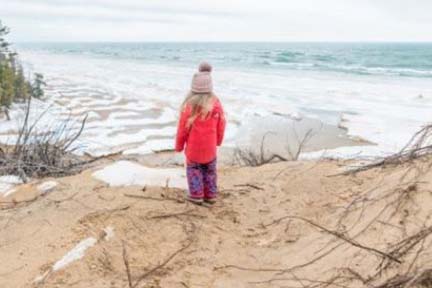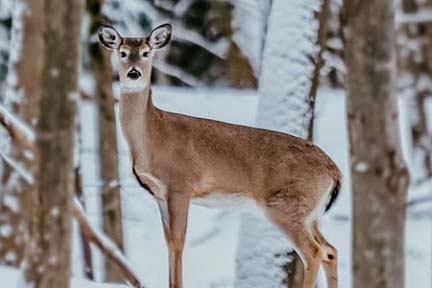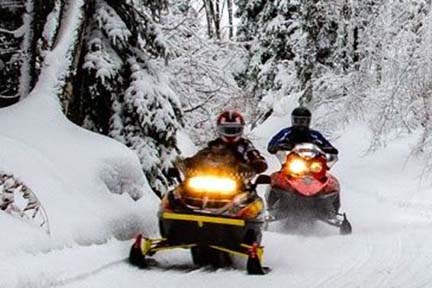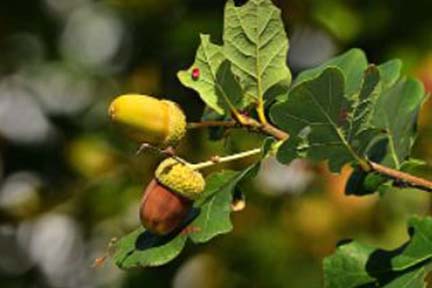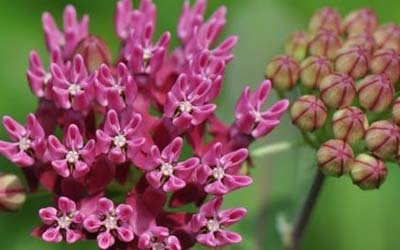| Here are a few of this week’s stories from the Michigan Department of Natural Resources:
See other news releases, Showcasing the DNR stories, photos and other resources at Michigan.gov/DNRPressRoom.
PHOTO FOLDER: Larger, higher-res versions of many of the images used in this email are available in this folder.
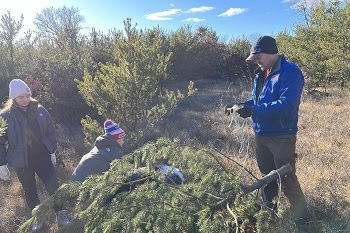 Looking to cut down a fresh-from-the-woods Christmas tree? You have options! Looking to cut down a fresh-from-the-woods Christmas tree? You have options!
First of all, though, cutting of Christmas trees is not allowed in Michigan state forests. Only dead and downed trees in certain areas are available to people who have purchased a $20 fuelwood permit.
However, you can buy a $5 permit to cut a tree in Michigan’s three national forests: the Huron-Manistee in the northern Lower Peninsula and the Hiawatha and Ottawa forests in the Upper Peninsula. Permits allow people to cut a Christmas tree within designated areas of the forest.
Trees are for personal use only and cannot be sold. All stumps must be cut within 6 inches of the ground, and you may not take a tree taller than 20 feet. You have to take the whole tree; don’t cut the top off of a taller tree.
If stomping through deep snow in the forest isn’t your jam, or you don’t live close to a national forest, good news: Michigan is among the nation’s top producers of Christmas trees and there are plenty of you-cut farms to help you find the perfect tree to bring a little piece of the forest inside for your holiday season.
To make sure your fresh tree stays that way, cut off about an inch on the base after you get it home to make sure it can take up water. Use a Christmas tree stand with a large water reservoir and check it daily. Display your tree away from heat sources such as fireplaces, vents or south-facing windows. Only use lights certified as safe by Underwriters Laboratories. Never leave lights on when you’re not home.
General questions about Michigan’s forests? Contact Kathleen Lavey at 517-930-4218 or visit Michigan.gov/Forestry. |
As winter begins across Michigan, bird-watchers are eagerly awaiting the arrival of winter finches moving in large numbers outside their typical range.
The latest winter finch forecast from the Finch Research Network predicts that purple finches, common and hoary redpolls, pine siskins and nomadic white-winged crossbills will move through the state this winter. As crops of berries, seeds and cones deplete throughout the winter, we could see some late movements of evening grosbeaks, pine grosbeaks and red crossbills into Michigan, though most movements will likely occur west of Lake Superior.
These birds depend on cone and berry crops of the boreal (northern) forest for food each winter. When there is not enough food, they will migrate outside their usual wintering grounds. This unusual migratory movement is called an irruption, which will bring northern finches south into lower Ontario, the Great Lakes and beyond. Irruptions don’t happen every year, which makes winter finch sightings particularly magical.
Learn how to identify, find and attract some of these winter gems.
Purple finch
 Males of this small finch species have a raspberry-red head, breast and back. Females have thickly streaked undersides, with a whitish eyebrow and a dark line down the side of the throat. Males of this small finch species have a raspberry-red head, breast and back. Females have thickly streaked undersides, with a whitish eyebrow and a dark line down the side of the throat.
- Find them in wooded and semiopen areas, including forests, suburbs, swamps and overgrown fields.
- Attract them with sunflower seeds, nyjer (a small, thin black seed) and millet. Use small and large tube feeders or hopper feeders. Plant native, seed-producing trees and grasses.
Pine siskin
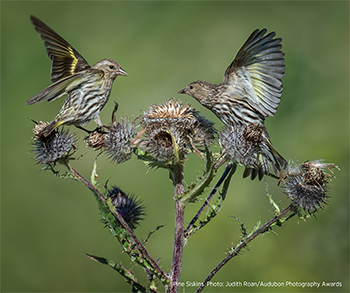 This bird behaves like a goldfinch but is brown and streaked like a sparrow. It has a sharp, pointed bill and subtle yellow edges on wing and tail feathers. This bird behaves like a goldfinch but is brown and streaked like a sparrow. It has a sharp, pointed bill and subtle yellow edges on wing and tail feathers.
- Find them in semiopen areas, woodland edges and weedy fields.
- Attract them with sunflower seeds and nyjer. Use small and large tube feeders and small hopper feeders. Plant native, seed-producing trees and grasses.
Read the full MI Birds story to learn more about the winter finches of Michigan.
MI Birds is a public outreach and engagement program created by Audubon Great Lakes and the DNR, which aims to increase all Michiganders’ engagement in the understanding, care and stewardship of public lands that are important for birds and local communities.
Questions? Contact Erin Rowan Ford at 313-820-0809. |
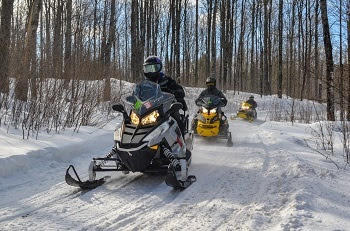 If your ideal winter day in Michigan involves hitting the snowmobile trails, and if having a say in the future of the state’s designated riding routes is important to you, the DNR wants to hear from you – your riding experience and insight could be a perfect fit for an open position on the Michigan Snowmobile Advisory Workgroup. If your ideal winter day in Michigan involves hitting the snowmobile trails, and if having a say in the future of the state’s designated riding routes is important to you, the DNR wants to hear from you – your riding experience and insight could be a perfect fit for an open position on the Michigan Snowmobile Advisory Workgroup.
“We’re looking for someone with a passion for snowmobiling and an interest in helping maintain and shape Michigan’s more than 6,200 miles of groomed snowmobile trails,” said Tim Novak, state trails coordinator for the DNR. “Specifically, we’re seeking an owner or operator of a snowmobile-related business to serve on the advisory workgroup, which plays a tremendous role in Michigan’s snowmobile community.”
The position could be filled by an individual who owns a power sports dealership, a repair facility or a hotel, gas station or other snowmobile tourism business, Novak said.
This new member will offer advice related to the creation, development, operation and maintenance of the designated snowmobile trail system. Other members of the workgroup represent trail sponsors, at-large trail users, the Michigan Snowmobile Association and the DNR.
Workgroup members help develop safety education and training programs, assist in determining how best to use funds from the DNR’s recreational snowmobile trail improvement fund, and serve as ambassadors and advocates on behalf of snowmobile users statewide.
The workgroup, which works closely with the Michigan Trails Advisory Council and the DNR Parks and Recreation Division, consists of seven individuals each serving four-year terms and contributing as volunteers (travel expenses to and from meetings are eligible for reimbursement). The group meets quarterly at varying locations around the state.
“Members tell us that being part of this workgroup is a rewarding experience – it’s not overly time-consuming and provides an opportunity for avid snowmobilers to express themselves and connect with others who enjoy the sport and wish to contribute to our state’s awesome snowmobile trail network,” Novak said.
Interested in getting involved and sharing your expertise? Apply for the position by filling out this form. The DNR will accept applications through Jan. 8. For more information, contact Anna Centofanti at 517-331-6219. |
 A round of special Inflation Reduction Act funding is available through the Forest Legacy Program to protect environmentally important forests. Funding will support projects in three key categories: large landscape projects, state-tribal projects and strategic small-tract projects. A round of special Inflation Reduction Act funding is available through the Forest Legacy Program to protect environmentally important forests. Funding will support projects in three key categories: large landscape projects, state-tribal projects and strategic small-tract projects.
In case you missed it, the deadline to nominate your forest land for proposal consideration is just over a week away, Dec. 15. Learn more about the opportunity and eligibility in a recent DNR news release.
Questions about the Forest Legacy Program or IRA funding opportunity? Contact program coordinator Kerry Heckman. |
 If you’re interested in helping protect, preserve and promote Michigan’s natural and cultural resources, here are a few ways you can get involved with the DNR in December. If you’re interested in helping protect, preserve and promote Michigan’s natural and cultural resources, here are a few ways you can get involved with the DNR in December.
Nurturing nature
Several state parks in southern Michigan will host volunteer stewardship workdays. Volunteers are needed to help restore natural areas by removing invasive plants that threaten high-quality ecosystems. Workdays will take place:
- 9 a.m. to noon Saturday, Dec. 9, at Bald Mountain Recreation Area (Oakland County).
- 10 a.m. to noon Saturday, Dec. 9, at Warren Dunes State Park (Berrien County).
- 10 a.m. to 1 p.m. Sunday, Dec. 10, at Island Lake Recreation Area (Livingston County).
- 10 a.m. to noon Sunday, Dec. 10, at Muskegon State Park (Muskegon County).
- 10 a.m. to 12:30 p.m. Friday, Dec. 15, at Yankee Springs Recreation Area (Barry County).
- 9 a.m. to noon Saturday, Dec. 16, at Belle Isle Park (Wayne County).
- 11 a.m. to 1:30 p.m. Saturday, Dec. 16, at Fort Custer Recreation Area (Kalamazoo County).
- 10 a.m. to 1 p.m. Sunday, Dec. 17, at Pinckney Recreation Area (Washtenaw County).
|
More details about each workday and how to register can be found on the DNR volunteer events calendar.
Bird counts
Enjoy bird-watching? You can help scientists better understand bird movement and population health and protect birds and their habitats by counting and reporting the birds you see this winter. Join these upcoming community science bird counts:
Gifts for good
Give holiday gifts that give back! Check some shopping off your list and support natural and cultural resources with our holiday gift guide. Find unique gifts for just about anyone on your list – choose from a variety of products benefiting Michigan’s state parks, trails and waterways, history and wildlife education programs, habitat restoration and management, and the Michigan Arctic Grayling Initiative.
For more ways to volunteer, contribute and provide input, visit Michigan.gov/DNRVolunteers.
 See more pictures by Michigan state parks photo ambassadors at Instagram.com/MiStateParks. For more on the program, call Stephanie Yancer at 989-274-6182. (This photo is by Jamie Ball, for the Michigan DNR, at Cheboygan State Park in Cheboygan County.) See more pictures by Michigan state parks photo ambassadors at Instagram.com/MiStateParks. For more on the program, call Stephanie Yancer at 989-274-6182. (This photo is by Jamie Ball, for the Michigan DNR, at Cheboygan State Park in Cheboygan County.)
|
